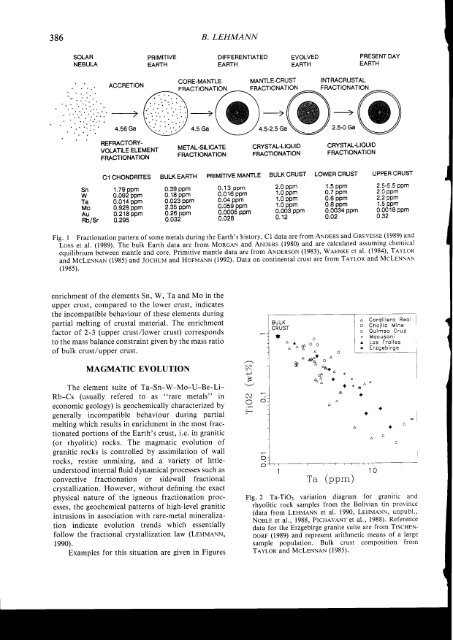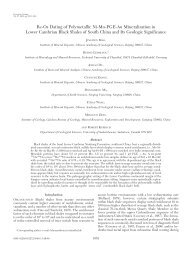Metallogeny of Granite-Related Rare-Metal Mineralization
Metallogeny of Granite-Related Rare-Metal Mineralization
Metallogeny of Granite-Related Rare-Metal Mineralization
You also want an ePaper? Increase the reach of your titles
YUMPU automatically turns print PDFs into web optimized ePapers that Google loves.
386 B. LEHMANN<br />
SOLAR<br />
NEBULA<br />
......<br />
PRIMITIVE<br />
EARTH<br />
DIFFERENTIATED<br />
EARTH<br />
AccREroN/_{nT;K[,\<br />
EVOLVED<br />
EARTH<br />
Sli,Lttä,?3il:T\<br />
;e ;@=@;<br />
PRESENT DAY<br />
EARTH<br />
REFRACTORY-<br />
VoLATILE ELEMENT<br />
FRACTTONATTON<br />
METAL-SILICATE<br />
FRACTIONATION<br />
CRYSTAL-LIOUID<br />
FRACTIONATION<br />
CRYSTAL-LIQUID<br />
FRACTIONATION<br />
C1 CHONDRITES BULK EARTH<br />
Sn 1.79 ppm 9.99 PPm<br />
W 0.092ppm 0.18PPm<br />
Ta 0.014 ppm 9.Q?3 PPm<br />
Mo 0.928 ppm 2.9! PPm<br />
Au 0.218 pPm 9.?Q PPm<br />
Rb/Sr 0.295 0.032<br />
PRIMTTIVE MANTLE BULK CRUST<br />
0.13 Dom 2'0 PPm<br />
0.016 öPm 1'0 PPm<br />
o.o4 obh 1.0 PPm<br />
0.05tä bpm 1.0 PPm<br />
0.0005 bom 0.003 PPm<br />
0.028<br />
'' 0.12<br />
LOWERCRUST<br />
UPPERCRUST<br />
1.5 ppm 2.5-5.5 PPm<br />
0.7 ppm 2.0 PPm<br />
0.6 ppm 2.2PPm<br />
0.8 bpm 1.5 PPm<br />
0.0Ö3+ ppm 0.00'18 PPm<br />
0.02 0.32<br />
Fig. I Fractionation pattern <strong>of</strong> some metals during the Earth's history. Cl data are from ANDERS and GRevpssr (1989) and<br />
Loss et al. (1989). The bulk Earth data are from MonceN and ANosns (1980) and are calculated assuming chemical<br />
equilibrium between manrle and core. Primitive mantle data are from ANopnsoN (1983), WAENKE et al' (1984)' TAYLOR<br />
und McLTNNAN (1985) and Jocuutra and HorvaNN (1992). Data on continental crust are from Tlvlon and McLENNAN<br />
0985).<br />
enrichment <strong>of</strong> the elements Sn, W, Ta and Mo in the<br />
upper crust, compared to the lower crust, indicates<br />
the incompatible behaviour <strong>of</strong> these elements during<br />
partial melting <strong>of</strong> crustal material. The enrichment<br />
factor <strong>of</strong> 2-3 (upper crust,/lower crust) corresponds<br />
to the mass balance constraint given by the mass ratio<br />
<strong>of</strong> bulk crust/upper crust.<br />
BULK<br />
CRUST<br />
t<br />
a Cordillero Real<br />
n Choillo Mine<br />
o Quimso Cruz<br />
* Mocusoni<br />
r Los Froiles<br />
+ frzgebirge<br />
MAGMATIC<br />
EVOLUTION<br />
The element suite <strong>of</strong> Ta-Sn-W-Mo-U-Be-Li-<br />
Rb-Cs (usually refered to as "rare metals" in<br />
economic geology) is geochemically characterized by<br />
generally incompatible behaviour during partial<br />
melting which results in enrichment in the most fractionated<br />
portions <strong>of</strong> the Earth's crust, i.e. in granitic<br />
(or rhyolitic) rocks. The magmatic evolution <strong>of</strong><br />
granitic rocks is controlled by assimilation <strong>of</strong> wall<br />
rocks, restite unmixing, and a variety <strong>of</strong> littleunderstood<br />
internal fluid dynamical processes such as<br />
convective fractionation or sidewall fractional<br />
crystallization. However, without defining the exact<br />
physical nature <strong>of</strong> the igneous fractionation processes,<br />
the geochemical patterns <strong>of</strong> high-level granitic<br />
intrusions in association with rare-metal mineralization<br />
indicate evolution trends which essentially<br />
follow the fractional crystallization law (LnuueNN,<br />
1990).<br />
Examples for this situation are given in Figures<br />
NO<br />
ö\<br />
+<br />
F<br />
F<br />
1 10<br />
Ta (PPm)<br />
Fig. 2 Ta-TiOz variation diagram for granitic and<br />
rhyolitic rock samples from the Bolivian tin province<br />
(data from LEnlraaNN et al. 1990, LnuranNN, unpubl.,<br />
Nosr-E et al., 1988, PIculveNr et al., 1988). Reference<br />
data for the Erzgebirge granite suite are from TtsculNoonr<br />
(1989) and represent arithmetic means <strong>of</strong> a large<br />
sample population. Bulk crust composition from<br />
TAYLoR and McLTNNaN (1985).










